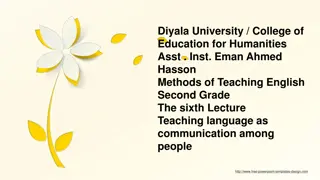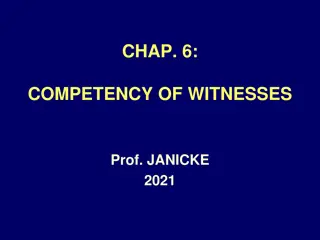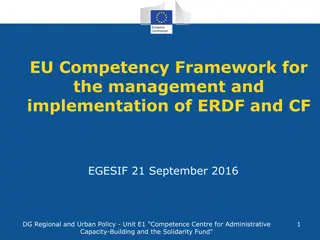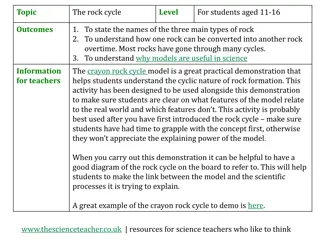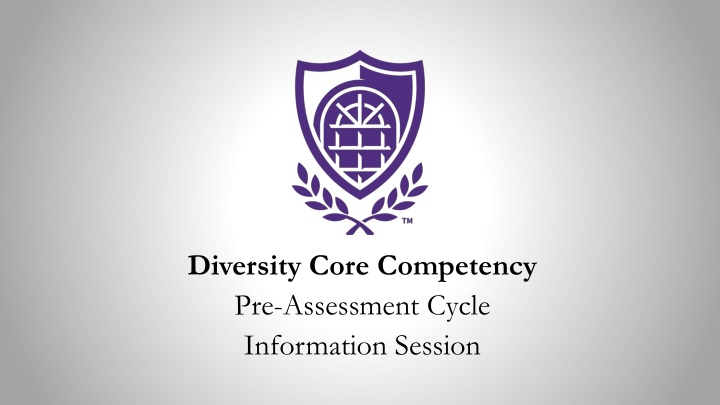
Diversity Core Competency Pre-Assessment Cycle Information Session
This session focuses on refreshing understanding of Diversity Rubrics, discussing student learning expectations, assignment selection, and design, learning about the assessment process, and addressing questions and concerns. The Assessment Cycle spans four years, with each year focusing on one aspect of each competency. The Assessment Process involves collecting artifacts, faculty development, scoring artifacts, processing data, interventions, and improvement teams. Competencies and scaffolding are divided into Lower Division, Upper Division, and Capstone levels. The goal is student learning in the UCA Core, with assessment aimed at ensuring programmatic cohesion and effectiveness. Goals of the assessment include integrity assurance, consistent use of best practices, optimizing student learning, identifying areas for improvement, and implementing improvement measures. Diversity in the UCA Core emphasizes analyzing familiar cultural assumptions and creative works in diverse cultural contexts
Download Presentation

Please find below an Image/Link to download the presentation.
The content on the website is provided AS IS for your information and personal use only. It may not be sold, licensed, or shared on other websites without obtaining consent from the author. If you encounter any issues during the download, it is possible that the publisher has removed the file from their server.
You are allowed to download the files provided on this website for personal or commercial use, subject to the condition that they are used lawfully. All files are the property of their respective owners.
The content on the website is provided AS IS for your information and personal use only. It may not be sold, licensed, or shared on other websites without obtaining consent from the author.
E N D
Presentation Transcript
Diversity Core Competency Pre-Assessment Cycle Information Session
In this Session we will: Refresh our understanding of the Diversity Rubrics Discuss expectations regarding student learning Discuss assignment selection and design Learn about the assessment process Ask questions, raise concerns
The Assessment Cycle A four year cycle. Each year we will focus on one aspect of each competency. The first four year cycle provides initial data. A second four cycle allows for an assessment of the process as a whole. A full programmatic assessment is recommended every 10 years. Academic Year 16-17 17-18 18-19 19-20 20-21 Assess RL D C CI RL Evaluate RL D C CI Train RL D C Implement RL D
The Assessment Process Collect Artifacts Faculty Development Score Artifacts Collect and Process Data Interventions Improvement Teams
The Competencies and Scaffolding Lower Division: Introduce and Develop Upper Division: Reinforce, and Demonstrate Mastery Capstone: Culminating Educational Experience
The Goal is Student Learning The goal of the UCA Core is to provide a common, foundational educational experience to all UCA undergraduate students. We chose these outcomes as the essential skills all UCA students should develop. We can only achieve this goal if we continuously evaluate the UCA Core curriculum and assess it for programmatic cohesion and effectiveness. Assessment is crucial for improvement! We all must do our part in our respective roles to provide our students the best education possible at UCA. Remember: This is about student learning.
The Goal of Assessment 1) Assure integrity in the UCA Core as an academic program. 2) Verify that best practices are being used consistently across campus. 3) Optimize student learning across the competencies at both the Lower and Upper Division. 4) Identify areas for improvement, and design and implement improvement measures.
What is Diversity in the UCA Core? Diversity: the ability to analyze familiar cultural assumptions in the context of the world s diverse values, traditions, and belief systems as well as to analyze the major ideas, techniques, and processes that inform creative works within different cultural and historical contexts. Intentionally vague: Applicable to all disciplines. Does not mandate any particular content. It s about perspectival diversity. An Intellectual Virtue: Communicates an expectation about fostering an intellectual disposition and experience in the learner. Minimal requirement: Faculty are free to do more, but courses designated as Diversity courses must at least align to one of the three rubrics under this competency. A Federalist Approach: Academic freedom and experimentation under a universal rule or guideline with oversight for compliance. See https://uca.edu/core/for-faculty/diversity-assessment/
Diversity Rubric A: Own One s own values and assumptions Direct versus Indirect Measures
Diversity Rubric B: Other Analyze or compare diverse perspectives Asks questions evaluates applies
Diversity Rubric C: Creative Works Theory, themes, contexts, and personal response Analyze works within diverse contexts
Expectations at all levels: From Lower to Upper Division courses, our expectations of students vary. But we should make sure to afford all students the opportunity to demonstrate excellence. That s how we learn where they are, so we can meet them there and promote growth. Diversity it broadly defined. No discipline owns it. No discipline is uniquely qualified. All measures that assess outcomes like empathy or curiosity are probably indirect measures. We can t know attitudes or mindsets, only outputs. It s about authentic experiences.
Assignment Choice and Design Your course aligns to the Core rubric. Your assignment should reflect this. Choose or craft an assignment wisely: 1) Near the end of the semester, 2) One that aligns well to the Core outcomes and prompts students to present performances that demonstrate their skills across the learning outcomes of the rubric. Questions to ask yourself: 1) Does your assignment explicitly prompt a student to demonstrate the skills your course develops and for which we are assessing? 2) Does your assignment provide an appropriate opportunity to demonstrate the student s skill level across the Core outcomes?
Lower Division Diversity (Example) Assesses under Goal A (Own) Self-Awareness, Empathy, Openness Length, prompts, description Opportunity to demonstrate full range of skills Provided by Dr. Donna Bowman
Upper Division Diversity (Example) Assesses under Goal B (Other) Cultural Worldview, Curiosity, Application Size/importance of assignment Scope and Expectation Provided by Dr. Thomas Snyder
Preparatory Work is Crucial For assessment to be meaningful we need the best information we can get. We need an accurate picture of your students. We need you to participate so we get representative data of the student population. We need the data we receive to accurately depict our students skill levels across the Core outcomes. This data will be used to evaluate and improve the general education program at UCA. Help us deliver to our students the best education we can; the education they deserve. QUESTIONS ?
Artifact Collection: The Survey Fall and Spring of assessment year, a survey is sent out from the office of assessment. What will you use for assessment? When will it be used? How will it be delivered? All artifacts entered into AQUA
Additional Info for the Survey Provide a syllabus Assignment instructions? Assignment expectations? A grading rubric? The scorers will be scoring the student s performance according to the Core rubric. They only have this singular performance to evaluate a student s competency. This is why assignment design and choice is crucial.
Looking ahead to Fall 2021 Please Participate 1) Complete the survey 2) Communicate with the Office of Assessment 3) Deliver your artifacts (student work) 4) Consider serving as a scorer! Questions: Contact Jake Held at jmheld@uca.edu or Alyson McEntire at amcentire@uca.edu
Questions? Comments?
Jake Held, PhD Professor of Philosophy Assistant Provost for Academic Assessment and General Education Wingo Hall 215 501-450-5307 jmheld@uca.edu












